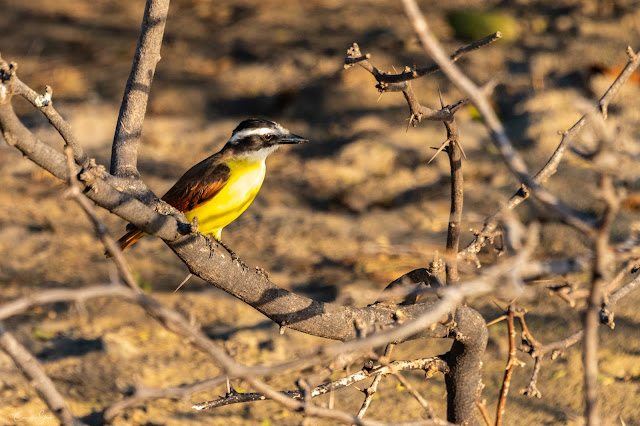Lucky for me, I was able to see a good variety of birds while in Costa Rica.
Some of the birds I was actually able to photograph, while others were fly overs with no time to set up and compose. Several of the photographs, because of the distance between me and the location they were perched on being greater than what my lens could handle, came out ......well you can see how they came out.
The first birds that caught my eye, because of the number of them flying around were the black birds. There are several types of black birds in this area. One of them is known as the Great-tailed Grackle.
This large, noisy bird has become amazingly adapted to living with people. A scavenger and opportunist of beaches, riversides, and wetlands, urban environments apparently mimic these open habitats because Great-tailed Grackles seem to be right at home as they forage on city streets, pick at garbage, and sing crazy songs from trees in a busy park. A large, black bird with a long, wedge-shaped tail seen when birding Costa Rica will be the male of this common species.
The next type of blackbirds found in this area are the Melodious Blackbird. They are very vocal birds.
Birders will hear their ringing song in most deforested areas of the country. This is pretty impressive considering that the Melodious Blackbird entered Costa Rica from Nicaragua only since the 1980s. This common, black-plumaged bird has a very generic bird shape. They sometimes occur in flocks but are most often seen as pairs perched together at the top of a tree in edge habitats. An American Robin or Eurasian Blackbird sized, all black bird with a medium length tail, flat head, and longish beak.
I found these guys to be the most fascinating birds to watch and to listen. They are called Montezuma Oropendola.
The English and scientific names of this species commemorate the Aztec emperor Moctezuma II. The sexes are very different in size; the male is 50 cm long and weighs 520 g; the smaller female is 38 cm long and weighs 230 g.
Adult males are mainly chestnut with a blackish head and rump, and a tail which is bright yellow apart from two dark central feathers. There is a bare blue cheek patch and a pink wattle, the iris is brown, and the long bill is black at the base with a red tip. Females are similar, but smaller than males with a smaller wattle. Young birds are duller than adults and have a paler and less demarcated bill. No subspecies are currently recognized.
The “unforgettable” song of the male Montezuma Oropendola is given during the bowing display, and consists of a conversational bubbling followed by loud gurgles. It is also a very common bird in parts of its range in Costa Rica. They are omnivorous and are often seen in small flocks foraging in trees for small vertebrates, large insects, nectar, and fruit including banana.
Listen to their call....to me it's quite an unforgettable sound.
The Social Fly Catcher, is found in very wide variety of woodlands.
Most often feeds on insects, fruits, and berries. They have also on occasion been found to feed on small vertebrates such as small frogs and tadpoles. Has a variety of harsh calls, including a buzzy trill, a sharp peeurrr, and a harsh twittering call.
The White Throated Magpiejay is between 43 to 56 cm (17–22 in) in length and weighs 205 to 213 g (7.2–7.5 oz). The species has a particularly long tail and a slightly curved crest of feathers on the head. The crest is black in the nominate race, but has blue or white margins on the other two subspecies. The nominate race has a white face with a black crown and margin to the face, forming a narrow band around the throat, as well as a small drop below the eye. The black is less extensive in the other subspecies. The breast, belly and underside of the rump are white, and the wings, mantle and tail are blue (with whitish margins on the tail). The legs and eye are black, and the bill is grey.
White-throated magpie-jays are omnivorous, consuming a wide range of animal and plant matter. Items included in the diet include invertebrates such as insects and caterpillars, frogs, lizards, eggs and nestlings of other birds, seeds, fruits, grain, and nectar from Balsa blossoms.
The White Tipped Dove is usually seen singly or in pairs, and is rather wary. Its flight is fast and direct, with the regular beats and clattering of the wings which are characteristic of pigeons in general. The call is a deep hollow ooo-wooooo.
More wild bird varieties in the next post.








































Love these!!!
ReplyDeleteThank you "Unknown" 😉
Delete"conversational bubbling followed by loud gurgles." Me after three ciders. 🤣 A stunning collection of beauties.
ReplyDeleteThank you 😉 (Only three? 😂)
Delete